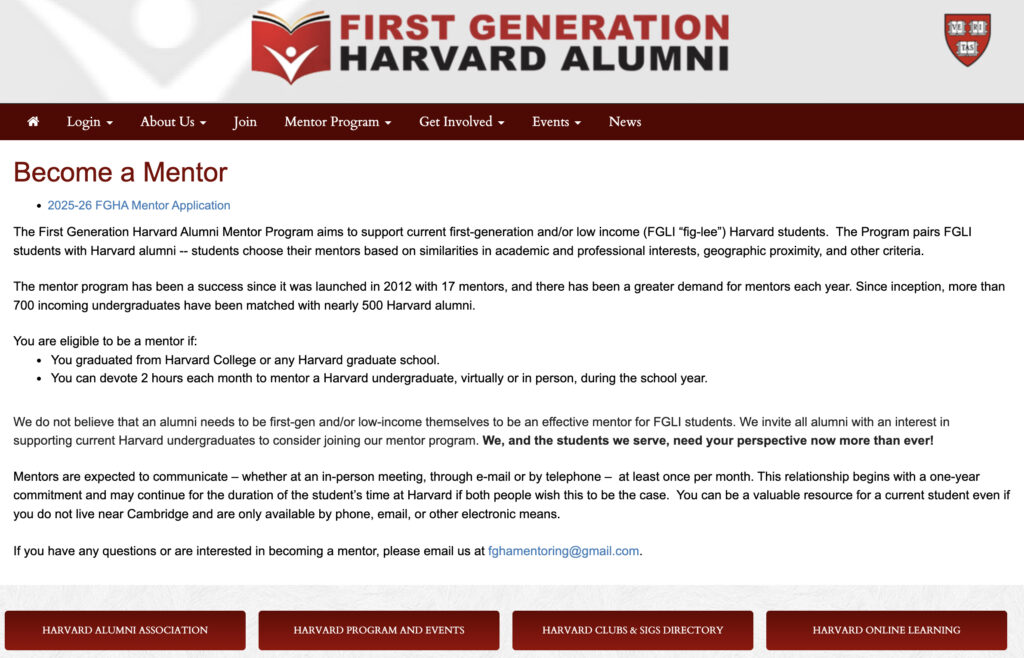
How to Launch an Alumni Mentorship Program That Actually Works
Learn how to launch an alumni mentorship program that drives real results. Get step-by-step strategies, proven examples, and the best mentorship platform tools.
Tasnova Chowdhury
Business Analyst
Alumni mentorship programs are changing how schools and universities prepare students for life beyond graduation. What started as informal coffee chats between alumni and students has evolved into a structured, high-impact approach to career development, confidence building, and lasting community engagement.
From Stanford to Oxford, mentorship has become one of the most powerful ways to transform alumni pride into tangible action. When designed with intention, it creates value for everyone. Students gain insider knowledge and professional networks. Alumni rediscover purpose through giving back. And institutions build stronger reputations while nurturing a culture of lifelong connection.
Despite growing interest, many institutions struggle to move from concept to execution. Questions surface around mentor recruitment, effective matching strategies, and measuring real outcomes without drowning in manual processes.
This guide will walk you through how to launch an alumni mentorship program that delivers results. You’ll learn from proven examples and discover how the right alumni software can simplify program management and fuel sustainable growth.
Why Alumni Mentorship Programs Matter
An alumni mentorship program goes far beyond professional networking. It’s a two-way relationship that sparks growth for mentors, mentees, and the institution itself. When executed well, everyone wins. Here is the benefits of Alumni Mentorship Program.
| Stakeholder | Key Benefits | Description |
|---|---|---|
| Mentor | Give Back to the Community | Mentors can contribute to the growth of the next generation and stay connected to their alma mater. |
| Personal Growth | Guiding others enhances leadership, empathy, and communication skills. | |
| Networking Opportunities | Mentors expand their own professional network by connecting with emerging talent and other mentors. | |
| Mentee | Career Guidance | Access to real-world insights, career advice, and industry connections. |
| Confidence and Skill Development | Regular mentor interactions build confidence, problem-solving, and soft skills. | |
| Expanded Network | Early exposure to professional networks helps in job placement and career exploration. | |
| Institution | Strengthened Alumni Relations | Encourages ongoing alumni involvement and loyalty. |
| Enhanced Student Success | Improves student employability and satisfaction rates. | |
| Positive Reputation | A thriving mentorship culture boosts the institution’s image and alumni pride. |
Key Challenges for Mentors, Mentees, and Institutions
While the benefits are substantial, mentorship programs often falter without clear structure or digital support. Each stakeholder faces distinct challenges that need early attention.
For Mentees
Many students and young professionals struggle to maximize mentorship because they lack clarity on goals or consistency. Common obstacles include:
- Uncertainty about what to expect or ask from mentors
- Difficulty maintaining regular communication or scheduling meetings
- Hesitation or imposter syndrome when reaching out to accomplished alumni
For Mentors
Even seasoned alumni can find mentoring challenging without proper frameworks or time management tools. They frequently encounter:
- Unclear expectations or misaligned goals with mentees
- Limited time to commit to consistent mentoring sessions
- Lack of resources or structure to track mentee development effectively
For Institutions
Running a mentorship program manually becomes overwhelming fast. Without automation or clear metrics, institutions face:
- Low participation due to weak onboarding or confusing communication
- Time-consuming manual coordination and matching processes
- No measurable data to evaluate program success
- Difficulty scaling the program to accommodate more participants
Step-by-Step: How to Launch an Alumni Mentoring Program
The good news? These obstacles are entirely preventable with the right approach. By following a structured launch process and leveraging purpose-built alumni software, you can design a mentorship experience that anticipates common pitfalls and sets participants up for success from day one. Let’s walk through exactly how to do that.
Step 1: Define Clear Goals and Purpose
Before launching your alumni mentorship program, establish what you want to accomplish. Every successful program starts with a focused vision. Whether it’s supporting students’ career development, helping recent graduates transition into their industries, or boosting alumni engagement within your community, clarity drives results.
Ask yourself critical questions like:
- What specific outcomes do mentors and mentees hope to achieve?
- How will mentorship strengthen our alumni network?
- What success metrics matter most: career placements, skill development, or sustained engagement?
A well-articulated purpose shapes your program structure, participant selection, and how you communicate value to your community.
Step 2: Design Your Program Structure
Once goals are set, map out how your alumni mentoring program will actually operate. A thoughtful framework ensures smooth onboarding, clear expectations, and meaningful mentor-mentee interactions.
Start by choosing your mentorship model. Some institutions prefer one-on-one pairings for deeper relationships, while others use group or peer mentoring to reach more participants simultaneously. Consider what fits your community’s size, needs, and mentor availability.
Next, establish the duration and format. Will it run year-round, or in fixed cycles like six-month cohorts? Decide how participants will connect: virtual meetings, in-person gatherings, or a hybrid approach.
To sustain engagement, outline a clear mentorship journey with defined milestones: onboarding, goal setting, progress check-ins, and program completion. Provide participants with resources like mentoring guides, conversation starters, and progress templates to structure the experience effectively.
Step 3: Recruit and Match Mentors and Mentees
Recruiting the right participants determines whether your alumni mentorship program succeeds or stalls. The quality of mentors and enthusiasm of mentees shape how meaningful and lasting connections become.
Start by reaching out to alumni passionate about contributing. Emphasize how mentoring helps them share expertise, expand networks, and stay connected to their alma mater. Promote opportunities through alumni newsletters, LinkedIn, university websites, or alumni events.
For mentees, target students and recent graduates seeking guidance on career growth, industry insights, or academic transitions. Simplify signup with an online form capturing their background, interests, and expectations.
Once both groups join, focus on creating strong matches. Effective matching goes beyond basic filters like department or graduation year. Factor in professional goals, skills, interests, and communication preferences.
Many institutions now use matching algorithms or alumni software that automates pairing based on compatibility. This saves time while ensuring fairness and transparency in selections.

Step 4: Onboard and Train Participants
After recruiting mentors and mentees, proper onboarding sets expectations, builds confidence, and creates alignment from day one. A structured onboarding process ensures participants understand what to expect, how to communicate, and how to maximize the relationship.
Begin with a welcome orientation (virtual or in-person) introducing program goals, timeline, and communication guidelines. This session helps everyone grasp the structure and their specific roles.
Provide mentorship toolkits for both mentors and mentees. Include conversation prompts, goal-setting templates, communication frequency recommendations, and confidentiality guidelines. These resources help participants navigate relationships with clarity and purpose.
Consider offering brief training sessions or webinars like “How to Be an Effective Mentor” or “Maximizing Your Mentorship Experience.” This prepares both sides to approach the program professionally and enthusiastically.
Encourage pairs to establish clear goals during their first meeting: developing specific skills, exploring career options, or preparing for interviews. Setting these objectives early makes measuring success easier later.
Step 5: Maintain Engagement and Measure Success
Launching your alumni mentoring program is just the start. Success depends on sustaining engagement over time. Continuous support, communication, and measurement keep mentors and mentees active and motivated.
Encourage regular check-ins. Whether weekly messages, biweekly calls, or monthly meetups, consistent communication helps relationships deepen naturally. Automated reminders like “Share one career insight this week” or “Set your next goal together” can prompt action.
Build engagement through community touchpoints. Organize group sessions, networking events, or themed discussions where participants connect with others in the program. This fosters belonging and enables learning from shared experiences.
Track progress systematically. Use surveys and feedback forms to evaluate mentorship quality, goal completion, and satisfaction. Simple ratings like “How valuable was your latest session?” measure impact without overwhelming participants.
Celebrate success stories. Feature inspiring mentor-mentee pairs in newsletters, social media, or alumni publications. This recognizes achievements while motivating others to participate.
Analyze participation data: active pairs, retention rates, engagement frequency. A structured mentorship platform makes this process seamless and transparent, helping you refine future iterations.
Real Examples of Successful Alumni Mentorship Programs
Understanding how other institutions have built thriving mentorship initiatives can inspire your own approach.
Harvard Alumni Association connects students and alumni across schools and disciplines. By focusing on shared interests and career goals, they’ve cultivated a culture of continuous support. Participants report higher confidence in career decisions, while alumni feel deeper connection to their alma mater.

University of Toronto partnered with networking platform 10,000 Coffees to match alumni and students for virtual coffee chats. The structured approach with guided prompts has generated thousands of meaningful connections and real-world career insights.
Notre Dame College Alumni Association Australia (NDCAA) has created a strong mentoring culture within its alumni network — helping former students guide the next generation of professionals and students. Through structured mentoring programs and alumni success stories shared on their website, NDCAA showcases how powerful alumni engagement can be when mentorship becomes a shared value.
With platforms like Gradnet, associations like NDCAA can streamline the mentoring process — from pairing mentors and mentees to tracking progress and celebrating success stories — all within one connected system

What Makes a Great Mentorship Platform
Even the most motivated alumni and students lose steam without proper infrastructure. A successful alumni mentorship program needs reliable alumni software that streamlines connections, tracks progress, and sustains engagement. That’s where a dedicated mentorship platform becomes essential.
Key Features to Look For
Goal Setting and Progress Tracking
Clear milestones help both sides stay focused. Platforms with built-in tracking make measuring engagement and monitoring outcomes straightforward.
Engagement Analytics
Institutions can only improve what they measure. The best systems provide analytics dashboards showing participation rates, satisfaction scores, and feedback summaries.
Integrated Events and Networking
Mentorship works best within a broader ecosystem. Integrating mentorship with alumni events, discussion groups, or job boards creates an active, continuous community experience.
Scalability and Simplicity
Whether your community has 500 or 50,000 members, your platform should make launching, managing, and expanding programs simple without technical complexity.
Smart Matching Capabilities
Manual pairing through spreadsheets often creates mismatched expectations. Quality platforms use filters like industry, goals, academic background, and interests to connect compatible mentors and mentees efficiently.
Schools and organizations that integrate mentorship with their broader alumni ecosystem (events, fundraising, career support) achieve stronger engagement and sustained participation. When your technology supports meaningful relationships, mentorship becomes more than a program. It becomes the heartbeat of your alumni network.
Conclusion: Building Lasting Connections Through Alumni Mentorship
An alumni mentorship program isn’t just a networking initiative. It’s a bridge between generations that transforms shared experiences into lasting value. For students, it unlocks career confidence and real-world perspective. For alumni, it’s an opportunity to give back, refine leadership skills, and stay connected to a community they value. And for institutions, it’s a proven strategy for building stronger alumni engagement, better outcomes, and more loyal networks.
From Stanford’s structured cohorts to Oxford’s one-on-one model, successful programs share one common trait: they make connection effortless. With clear goals, thoughtful pairing, and the right alumni software, any school or organization can achieve similar results.
If you’ve been considering launching or improving your alumni mentoring program, now is the ideal time. A structured, data-driven approach can transform how your community grows, learns, and supports one another for years ahead.
Ready to see how real alumni communities are doing it? Explore how platforms like Gradnet help institutions launch, manage, and scale mentorship programs that actually work, all in one place.
Book a Free Demo Today and start building a mentorship experience your alumni will truly value.
A Smarter Way to Build Community
Gradnet centralizes everything—members, events, and fundraising—so your community can grow effortlessly.
